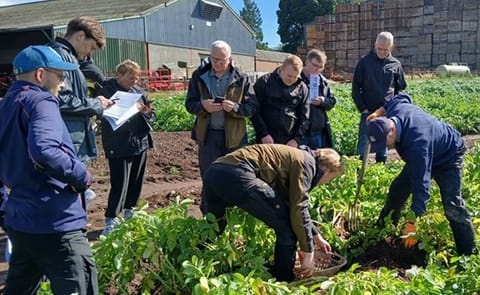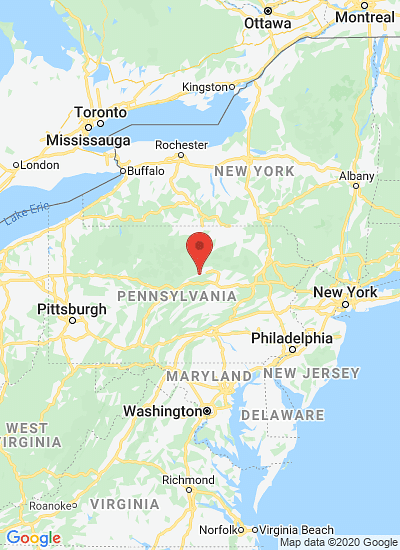Potato leaf blight on maincrop potato foliage, a fungal problem Phytophthora Infestans and is a disease which causes spotting on late potato leaves.
New Portable Device Uses Smartphone-Based Spectroscopy to Detect Late Blight Disease in Potato Crops

Researchers have developed a new smartphone-based portable device for detecting late blight disease in potato plants. It uses the visible-near-infrared Diffuse Reflectance Spectroscopy (DRS) technique.
Caused by fungus Phytophthora infestans, late blight disease is a significant problem for potato farmers worldwide. The disease can cause substantial yield losses and reduce the quality of the potatoes. Unfortunately, current methods for detecting late blight disease are manual and time-consuming.
They also require specialized equipment, making it difficult for farmers to quickly and accurately identify the disease. The traditional method of detecting late blight disease involves visually inspecting the plants that can lead to inaccuracies.
However, the latest portable DRS method detects the disease in potato leaves before any visible symptoms appear. This method is non-destructive, efficient, and accurate, making it a more reliable alternative to traditional inspection methods. The prototype of a handheld spectrophotometer can be connected to a smartphone via a micro-USB cable.
The device uses DRS method to measure the chemical composition of a plant leaf by shining light and measuring the reflected light in the wavelength range of 600 to 950 nm, representing visible and shortwave near-infrared spectral regions.
With the help of a smartphone app, researchers and farmers can use the device for non-invasive in-field leaf measurement and store data. In addition, the portable and user-friendly device can detect plant diseases, making it a convenient tool.
The DRS method accurately detects late blight disease in potato leaves before any visible symptoms appear. The reflected light carries vital information about the chemical composition of the leaf, including biomolecules that indicate the presence of certain diseases.
To test the method, researchers used the device on potato leaves infected with late blight disease and found that it accurately detected the condition. It offers several advantages over traditional methods. Firstly, it is non-destructive, meaning it doesn't harm the plant, which can continue to grow and produce potatoes.
Additionally, this new method is more efficient and accurate, taking only a few seconds to collect a measurement, and has a sensitivity and specificity of over 90%. The potential applications of the DRS method go beyond detecting late blight disease in potato crops.
The researchers suggest that it could be adapted for other crops and diseases, allowing farmers to identify and respond to various plant health threats quickly. Additionally, the DRS method could be used for routine checks and monitoring of potato crops for late blight disease and rapidly screening potato varieties for resistance to the disease.
This would help farmers to choose types that are less susceptible to infection and ultimately improve crop yields. In addition, it reduces economic losses due to plant disease. Portable DRS has a significant potential to be used as a tool for rapid and non-destructive detection of plant diseases, with broad implications for the agricultural industry.
Additionally, the device is portable and easy to use, making it ideal for on-site testing. Farmers can quickly and accurately identify the disease without sending samples to a laboratory for analysis.
Consequently, it's accessible to farmers in developing countries who may not have access to expensive laboratory equipment. The development of this device represents an exciting advancement in the field of plant pathology.
Caused by fungus Phytophthora infestans, late blight disease is a significant problem for potato farmers worldwide. The disease can cause substantial yield losses and reduce the quality of the potatoes. Unfortunately, current methods for detecting late blight disease are manual and time-consuming.
They also require specialized equipment, making it difficult for farmers to quickly and accurately identify the disease. The traditional method of detecting late blight disease involves visually inspecting the plants that can lead to inaccuracies.
However, the latest portable DRS method detects the disease in potato leaves before any visible symptoms appear. This method is non-destructive, efficient, and accurate, making it a more reliable alternative to traditional inspection methods. The prototype of a handheld spectrophotometer can be connected to a smartphone via a micro-USB cable.
The device uses DRS method to measure the chemical composition of a plant leaf by shining light and measuring the reflected light in the wavelength range of 600 to 950 nm, representing visible and shortwave near-infrared spectral regions.
With the help of a smartphone app, researchers and farmers can use the device for non-invasive in-field leaf measurement and store data. In addition, the portable and user-friendly device can detect plant diseases, making it a convenient tool.
The DRS method accurately detects late blight disease in potato leaves before any visible symptoms appear. The reflected light carries vital information about the chemical composition of the leaf, including biomolecules that indicate the presence of certain diseases.
To test the method, researchers used the device on potato leaves infected with late blight disease and found that it accurately detected the condition. It offers several advantages over traditional methods. Firstly, it is non-destructive, meaning it doesn't harm the plant, which can continue to grow and produce potatoes.
Additionally, this new method is more efficient and accurate, taking only a few seconds to collect a measurement, and has a sensitivity and specificity of over 90%. The potential applications of the DRS method go beyond detecting late blight disease in potato crops.
The researchers suggest that it could be adapted for other crops and diseases, allowing farmers to identify and respond to various plant health threats quickly. Additionally, the DRS method could be used for routine checks and monitoring of potato crops for late blight disease and rapidly screening potato varieties for resistance to the disease.
This would help farmers to choose types that are less susceptible to infection and ultimately improve crop yields. In addition, it reduces economic losses due to plant disease. Portable DRS has a significant potential to be used as a tool for rapid and non-destructive detection of plant diseases, with broad implications for the agricultural industry.
Additionally, the device is portable and easy to use, making it ideal for on-site testing. Farmers can quickly and accurately identify the disease without sending samples to a laboratory for analysis.
Consequently, it's accessible to farmers in developing countries who may not have access to expensive laboratory equipment. The development of this device represents an exciting advancement in the field of plant pathology.
Like to receive news like this by email? Join and Subscribe!
Get the latest potato industry news straight to your WhatsApp. Join the PotatoPro WhatsApp Community!
Highlighted Company
Sponsored Content
Sponsored Content
Sponsored Content
Sponsored Content







